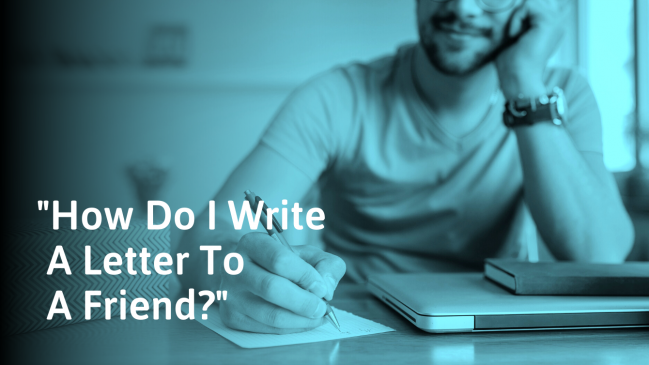Whether typed or handwritten, letters often feel more personal than emails or texts. So, if you want to make a friend feel special, why not write to them? In this article, you’ll pick up some tips for writing meaningful letters to a friend.
How to write a letter to a friend
When you’re writing to a friend, you want your letter to be heartfelt, clear, and interesting enough to hold their attention. Here are some tips for writing a proper letter that your friend will be glad to receive.
1. Write your address and the date on the first page
Write your current address and the date on the top-right corner of the first page of your letter. If your friend keeps your letter and rereads it later, they won’t have to remember when you sent it or where you were writing from.
If you aren’t sure how to format a letter, you could refer to an online template to help you get the layout right. For example, here is a list of informal letter templates.
2. Begin with a casual greeting
If you’re writing to a friend, you probably want to go for an informal tone in your letter. Pick a greeting that fits your personality and the relationship you have with your friend.
Here are some sample greetings you could use at the beginning of your letter:
- “Hey”
- “Howdy”
- “To my best friend…”
- “What’s up?”
- “Hi”
- “Hello”
- “Dear [friend’s name]”
- “Surprise! It’s me”
3. Acknowledge your friend
It’s polite to start your letter by acknowledging the person reading it. One or two sentences is enough. In general, it’s best to be brief and positive.
Here are some examples of ways to acknowledge your reader at the beginning of a letter:
- “I hope everything is good with you.”
- “I can’t believe it’s summer already! I bet it’s hot where you are.”
- “I hope you’re having an awesome semester.”
- “I hope you and your family are all doing well.”
4. Tell your friend why you are writing to them
To smooth the transition between your acknowledgment and the main body of your letter, give your friend some context by explaining why you are writing to them. One or two sentences is enough.
Here are some lines you use to explain why you are writing to your friend:
- “I realized the other day that it’s been too long since we talked, so I thought I’d write to you.”
- “I know you’ve been feeling down lately and thought a silly letter might put a smile on your face.”
- “I’ve got something amazing to tell you!”
- “Texting is great, but it gets a bit old sometimes, so I thought I’d write you a letter!”
- “I wanted to express my sympathy for the death of your grandmother.”
- “I’ve got something important that I need to share with you.”
5. Plan the main body of your letter
After greeting your friend and explaining why you are writing, you can start on the main body of the letter. It’s a good idea to make a rough plan first. It can help to make a bulleted list of everything you’d like to cover. If you stick to the list, you won’t miss anything out.
Most people begin with their most interesting or important news. For example, if you’ve just landed a new job, you might want to talk about that first.
However, you don’t have to follow this rule. Feel free to experiment with different structures. For example, you may want to share a funny but unimportant piece of news or gossip before talking about a significant thing that’s been happening in your life.
Use paragraph divisions to make your letter easy to read. In general, it’s best to start a new paragraph whenever you change the subject or want to make a new point.
6. Follow up on your last conversation or letter
Follow up on anything interesting your friend has told you recently, or reply to any questions they’ve asked you. This will make your letter more engaging and shows your friend that you pay attention to what they say.
Here are some examples of how you might follow up on a previous conversation or letter:
- “The last time we spoke, you were thinking of getting a new job. Did you apply for anything yet?”
- “In your letter, you asked me whether I’d ever think of starting my own business. I’ve thought about it, and…”
- “I was thinking about that conversation we had about bucket list trips. So it’s kind of a crazy idea, but maybe when we’ve graduated, we could visit…”
7. Ask your friend questions
Show your friend that you are thinking about them by asking questions about whatever is going on in their life. You could ask about something specific or ask an open question that encourages them to share anything they’d like you to know about.
For example, if you recently learned that your friend got engaged, you could ask a specific question like, “I still can’t believe you got engaged! How’s the wedding planning going?” or “Have you picked out a venue yet?”
Or, if you want to ask your friend a more general question, you could ask, “What’s going on with you?” or “What’s been happening in your life recently?”
8. Ask your friend to pass on messages to others
If there’s someone in your friend’s life that you know and care about but aren’t especially close to, you could ask your friend to pass on a quick greeting or message on your behalf.
For example, you could ask your friend to send your regards to their mother, to say “hi” to their kids, or to wish their partner a happy birthday.
9. Share a memory
Referencing a shared memory adds a personal touch to the letter and encourages your friend to think of the happy times you’ve shared.
Here are some examples of how to share a memory in a letter:
- “I had the most amazing sundae the other day. It reminded me of all those ice cream parties we had in college! Do you remember the time we set up an ice cream bar in the kitchen?”
- “My neighbor just got a new dog. Do you remember that time a crazy dog just randomly came up to us in the park and started trying to chew your coat? Yeah, this new dog reminds me of him. Not good.”
10. Show appreciation for your friend
If your friendship means a lot to you, a letter can be a good way to express your appreciation.
Here are some examples showing how you show appreciation in a letter:
- “By the way, I’ll always be grateful for your support when I split up with [your ex].”
- “I don’t think I’ve told you this lately, but your friendship means a lot to me.”
- “Even though we live far apart now, I still consider you to be one of my best friends.”
11. Use humor carefully
Even if you and your friend have a shared sense of humor, it’s important to remember that jokes, flippant comments, or sarcastic remarks don’t always come across the same way when they’re written down. Unless you’re sure that your friend will understand your meaning, avoid potentially offensive or controversial jokes.
12. Bring your letter to a close
When you’ve finished the main body of your letter, add a couple of sentences to wrap it up. You could tell them that you’ll be in touch, ask them to get in contact, remind them of an upcoming event or, if you’re writing to a friend you miss, let them know that you miss them.
Here are some ways you can bring a letter to a close:
- “So, that’s all my news. Hope to see you soon.”
- “I think that’s everything for the time being. Missing you! I’ll call you next week.”
- “I’ll sign off for now. Let me know when you’re next in town. Perhaps we could grab a drink.”
- “OK, I think you know everything that’s been going on with me now! See you soon at Jen’s birthday party!”
It’s good manners to end on a positive note, or at least to avoid signing off with a complaint.
For example, if you’ve been writing about a few problems you’ve been faced with over the past several months, you could end with, “It’s been a tough year, but I’m looking forward to seeing you soon!”
13. Sign off
Finish your letter with a warm or affectionate ending. Just like the greeting, it should fit your personality and the type of relationship you have with your friend.
Here are some ways you could sign off a letter to a friend:
- “Fondly”
- “Hugs and kisses”
- “With love”
- “All my love”
- “Affectionately”
- “See you soon!”
- “Cheers”
- “Your friend”
- “Yours”
- “Take care”
- “Thinking of you”
Don’t forget to sign off with your name.
14. Add a “P.S.”
You don’t have to add a P.S. to the end of your letter, but it can add some extra humor and is a good place to include an in-joke. For example, you could write, “P.S. You still owe me that $1.72. I expect you to pay up the next time I see you!”
You can also use a P.S. to include a short piece of news or information you forgot to include in your letter. For example, “P.S. I finally signed up for that calligraphy course. So maybe the next letter I write will be in fancy handwriting!”
15. Proofread your letter before sending it
A couple of small mistakes aren’t a big deal, but if your letter contains a lot of errors, it could be difficult for your friend to read or understand it. Double-check your letter before mailing it off.
You don’t need to rewrite the whole page if you make a couple of minor mistakes. You can cross out the mistake, add an asterisk, then add another asterisk at the bottom of the page, followed by the correction.
16. Make your letter special
A few nice touches will make your letter more memorable. Here are some ways you can make your letter more special:
- Use fancy notepaper or headed paper
- Include a photo that will mean something to your friend, e.g., an old picture of you together
- Decorate the letter or envelope with stickers or stamps
- Use an unusual-colored ink
- Include a small gift or trinket, such as a gourmet tea bag or pin badge
- Add sketches or doodles to the letter
You might also get some inspiration from these thank you messages for friends.
Common questions
How much should I write in a letter to a friend?
There is no hard and fast rule. If you have a lot to say, and you think your friend will enjoy reading it, it’s fine to write a long letter. But a short note can be very meaningful. For example, a few brief, sympathetic lines can be enough to comfort a grieving friend.








Do you have to add a postcard stamp on your letter or is it just optional?
thanks for the shared information
Hi Viktor:
I ran across your site and read some helpful information on how to make friends. I have relocated from Malibu to Seattle since 2018. We had lost our condo in the California wildfires and then Covid hit.
I am struggling to make new friends here and that is weird because I am a very happy social person.
So I thought I would start here and say, “hello”. Sincerly, Elaine Baer
Okay I guesssss
Oh I think this can really educate people